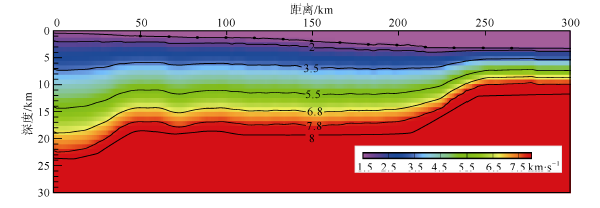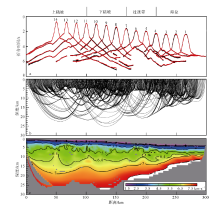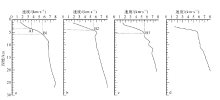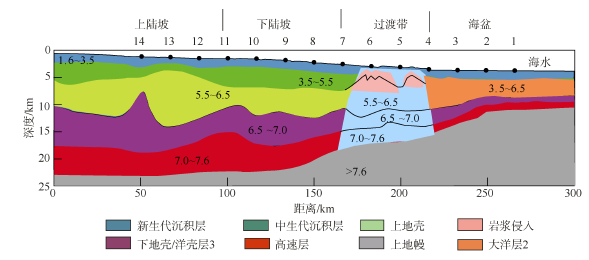| [1] |
郝沪军, 林鹤鸣, 杨梦雄, 等, 2001. 潮汕坳陷中生界——油气勘探的新领域[J]. 中国海上油气(地质), 15(3): 157-163.
|
|
HAO HUJUN, LIN HEMING, YANG MENGXIONG, et al, 2001. The Mesozoic in Chaoshan Depression: A new domain of petroleum exploration[J]. China Offshore Oil and Gas (Geology), 15(3): 157-163 (in Chinese).
|
| [2] |
吕修亚, 阎贫, 陈洁, 等, 2009. 折射方法在南海北部潮汕坳陷中生界地层研究中的应用[J]. 热带海洋学报, 28(1): 43-47.
|
|
LÜ XIUYA, YAN PIN, CEHN JIE, et al, 2009. Application of refraction velocity in studing Mesozoic strata in Chaoshan Depression on northern margin of South China Sea[J]. Journal of Tropical Oceanography, 28(1): 43-47 (in Chinese).
|
| [3] |
邱燕, 王立飞, 黄文凯, 等, 2016. 中国海域中新生代沉积盆地[M]. 北京: 地质出版社: 114.
|
| [4] |
邵磊, 尤洪庆, 郝沪军, 等, 2007. 南海东北部中生界岩石学特征及沉积环境[J]. 地质论评, 53(2): 164-169.
|
|
SHAO LEI, YOU HONGQING, HAO HUJUN, et al, 2007. Petrology and depositional environments of Mesozoic strata in the Northeastern South China Sea[J]. Geological Review, 53(2): 164-169 (in Chinese).
|
| [5] |
吴振利, 李家彪, 阮爱国, 等, 2011. 南海西北次海盆地壳结构: 海底广角地震实验结果[J]. 中国科学: 地球科学, 41(10): 1463-1476.
|
|
WU ZHENLI, LI JIABIAO, RUAN AIGUO, et al, 2012. Crustal structure of the northwestern sub-basin, South China Sea: Results from a wide-angle seismic experiment[J]. Science China Earth Sciences, 55(1): 159-172.
|
| [6] |
姚伯初, 曾维军, 陈艺中, 等, 1995. 南海北部陆缘东部中生代沉积的地震反射特征[J]. 海洋地质与第四纪, 15(1): 81-90.
|
|
YAO BOCHU, ZENG WEIJUN, CHEN YIZHONG, et al, 1995. Seismic reflective characteristics of Mesozoic sediments on the eastern continental margin in the North of the South China Sea[J]. Marine Geology & Quaternary Geology, 15(1): 81-90 (in Chinese).
|
| [7] |
张莉, 张光学, 王嘹亮, 等, 2014. 南海北部中生界分布及油气资源前景[M]. 北京: 地质出版社: 208-211.
|
| [8] |
周蒂, 王万银, 庞雄, 等, 2006. 地球物理资料所揭示的南海东北部中生代俯冲增生带[J]. 中国科学 D辑: 地球科学, 36(3): 209-218.
|
|
ZHOU DI, WANG WANYIN, PANG XIONG, et al, 2006. Mesozoic subduction-accretion zone in northeastern South China Sea inferred from geophysical interpretations[J]. Science in China: Series D Earth Sciences, 49(5): 471-482.
|
| [9] |
BOILLOT G, RECQ M, WINTERER E L, et al, 1987. Tectonic denudation of the upper mantle along passive margins: a model based on drilling results (ODP Leg 103, western Galicia margin, Spain)[J]. Tectonophysics, 132(4): 335-342.
|
| [10] |
ČERVENÝ V, MOLOTKOV J A, PSENCIK I, 1977. Ray Method in Seismology[M]. Prague: Charles University Press.
|
| [11] |
CHRISTESON G, 1998. OBSTOOL: Software for Processing UTIG OBS Data[M]. Austin: Institute for Geophysics, University of Texas.
|
| [12] |
FRANKE D, 2013. Rifting, lithosphere breakup and volcanism: comparison of magma-poor and volcanic rifted margins[J]. Marine and Petroleum Geology, 43: 63-87.
|
| [13] |
GERNIGON L, RINGENBACH J C, PLANKE S, et al, 2004. Deep structures and breakup along volcanic rifted margins: insights from integrated studies along the outer Vøring Basin (Norway)[J]. Marine and Petroleum Geology, 21(3): 363-372.
|
| [14] |
HAO HUJUN, ZHANG XIANGTAO, YOU HONGQING, et al, 2009. Characteristics and hydrocarbon potential of Mesozoic strata in eastern Pearl River Mouth Basin, Northern South China Sea[J]. Journal of Earth Science, 20(1): 117-123.
|
| [15] |
MJELDE R, KASAHARA J, SHIMAMURA H, et al, 2002. Lower crustal seismic velocity-anomalies; magmatic underplating or serpentinised peridotite? Evidence from the Vøring Margin, NE Atlantic[J]. Marine Geophysical Researches, 23: 169-183.
|
| [16] |
NIRRENGARTEN M, GERNIGON L, MANATSCHAL G, 2014. Lower crustal bodies in the Møre volcanic rifted margin: Geophysical determination and geological implications[J]. Tectonophysics, 636: 143-157.
|
| [17] |
NISSEN S S, HAYES D E, BUHL P, et al, 1995. Deep penetration seismic soundings across the northern margin of the South China Sea[J]. Journal of Geophysical Research, 100(B11): 22407-22433.
|
| [18] |
RESTON T J, 2009. The structure, evolution and symmetry of the magma-poor rifted margins of the North and Central Atlantic: A synthesis[J]. Tectonophysics, 468(1-4): 6-27.
|
| [19] |
SAWYER D S, WHITMARSH R B, KLAUS A, 1994. Explanatory notes[C]//Proceedings of the Ocean Drilling Program, Initial Reports. College Station, TX: Ocean Drilling Program: 1-25.
|
| [20] |
TAYLOR B, HAYES D E, 1983. Origin and history of the South China Sea basin[M]//HAYES D E. The Tectonic and Geologic Evolution of Southeast Asian Seas and Islands: Part 2. Washington, DC: American Geophysical Union, 27: 23-56.
|
| [21] |
WANG T K, CHEN MINGKAI, LEE C S, et al, 2006. Seismic imaging of the transitional crust across the northeastern margin of the South China Sea[J]. Tectonophysics, 412(3-4): 237-254.
|
| [22] |
WHITE R, MCKENZIE D, 1989. Magmatism at rift zones: the generation of volcanic continental margins and flood basalts[J]. Journal of Geophysical Research, 94(B6): 7685-7729.
|
| [23] |
WHITMARSH R B, BESLIER M O, WALLACE P J, 1998. Return to Iberia[C]//Proceedings of the Ocean Drilling Program, Initial Reports, 173. College Station, TX: Ocean Drilling Program: 1-30.
|
| [24] |
WU JINMIN, 1994. Evaluation and models of Cenozoic sedimentation in the South China Sea[J]. Tectonophysics, 235(1-2): 77-98.
|
| [25] |
YAN PIN, WANG LIAOLIANG, WANG YANLI, 2014. Late Mesozoic compressional folds in Dongsha waters, the northern margin of the South China Sea[J]. Tectonophysics, 615-616: 213-223.
|
| [26] |
YAN PIN, ZHOU DI, LIU ZHAOSHU, 2001. A crustal structure profile across the northern continental margin of the South China Sea[J]. Tectonophysics, 338(1): 1-21.
|
| [27] |
ZELT C A, BARTON P J, 1998. Three-dimensional seismic refraction tomography: A comparison of two methods applied to data from the Faeroe Basin[J]. Journal of Geophysical Research, 103(B4): 7187-7210.
|
| [28] |
ZELT C A, SMITH R B, 1992. Seismic traveltime inversion for 2-D crustal velocity structure[J]. Geophysical Journal International, 108(1): 16-34.
|
| [29] |
ZHAO MINGHUI, QIU XUELIN, XIA SHAOHONG, et al, 2010. Seismic structure in the northeastern South China Sea: S-wave velocity and Vp/Vs ratios derived from three-component OBS data[J]. Tectonophysics, 480(1-4): 183-197.
|
 ), Pin YAN1(
), Pin YAN1( ), Yanlin WANG1, Guangjian ZHONG3
), Yanlin WANG1, Guangjian ZHONG3



















